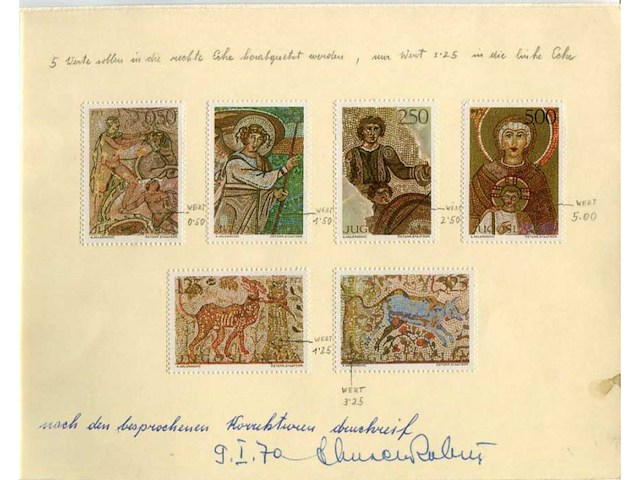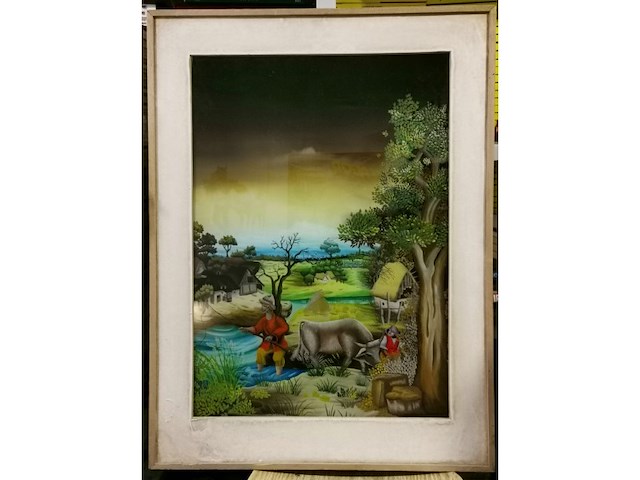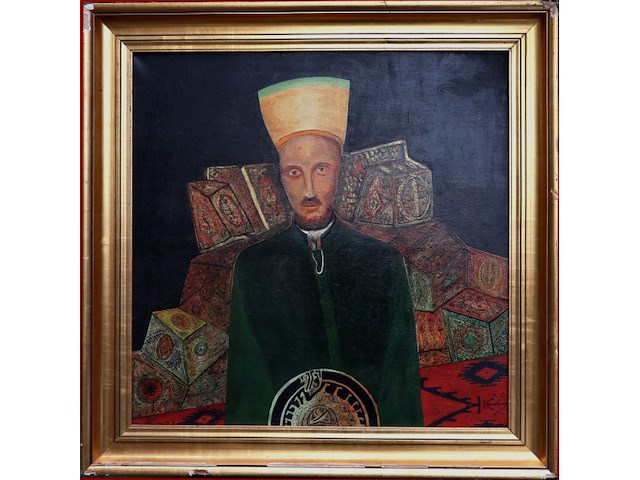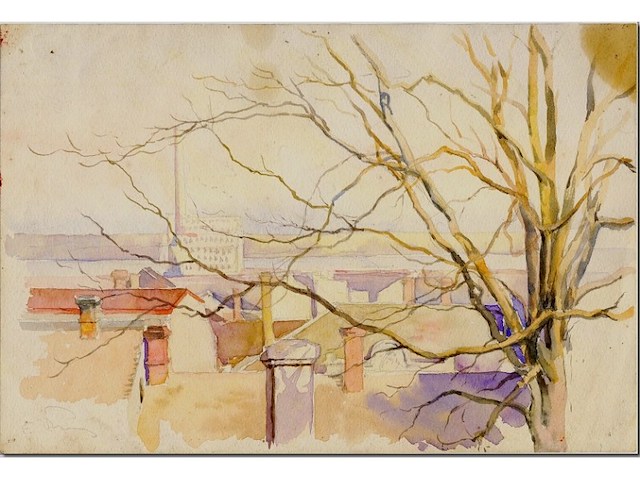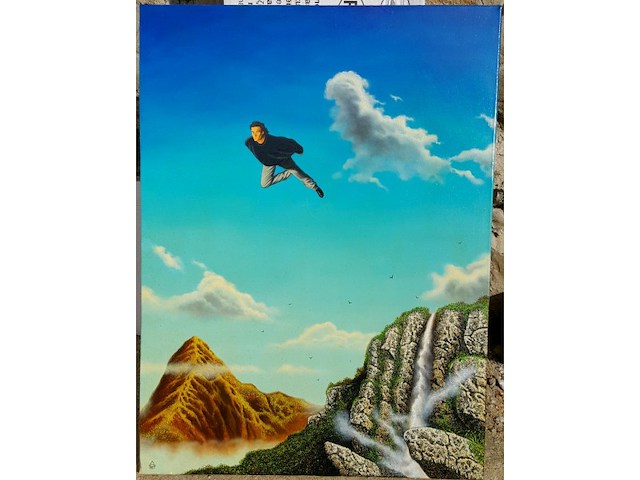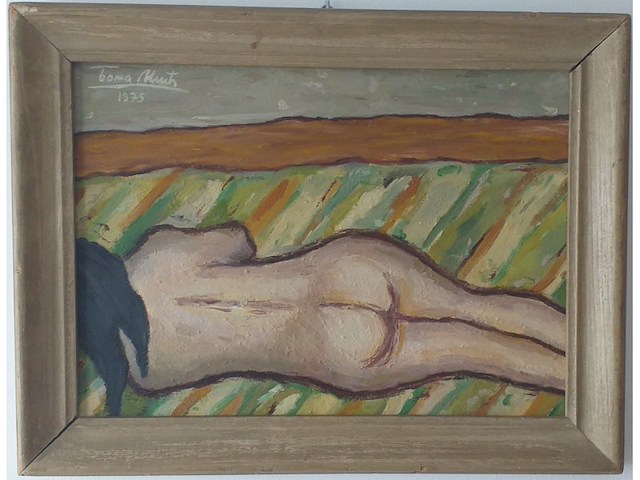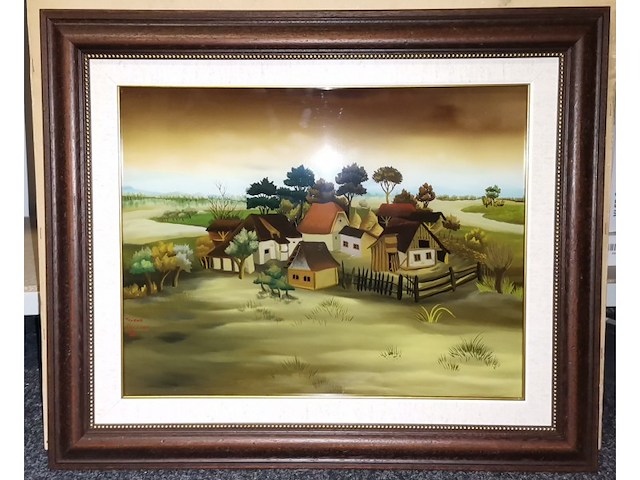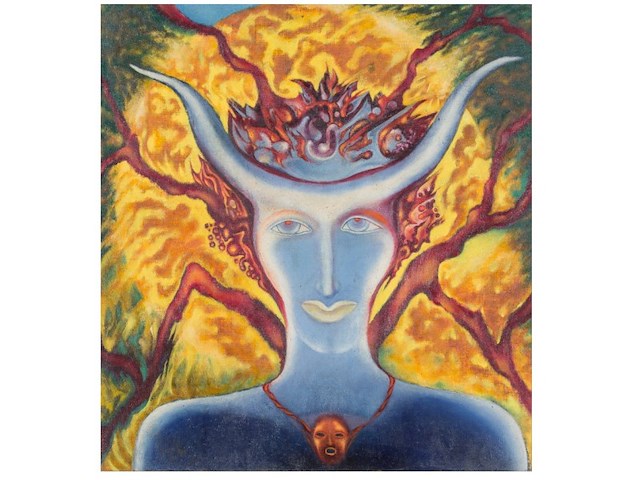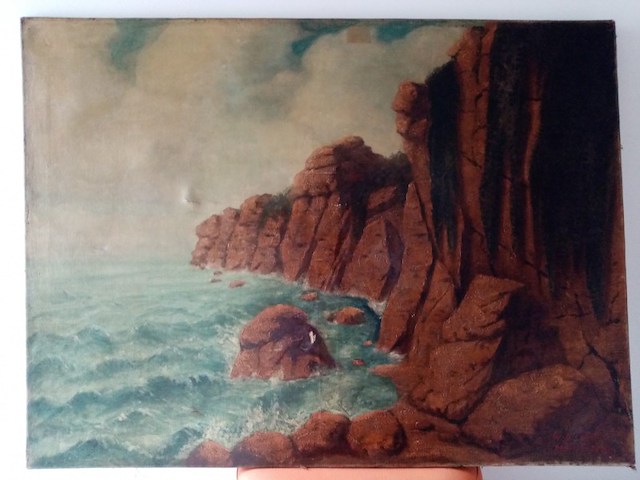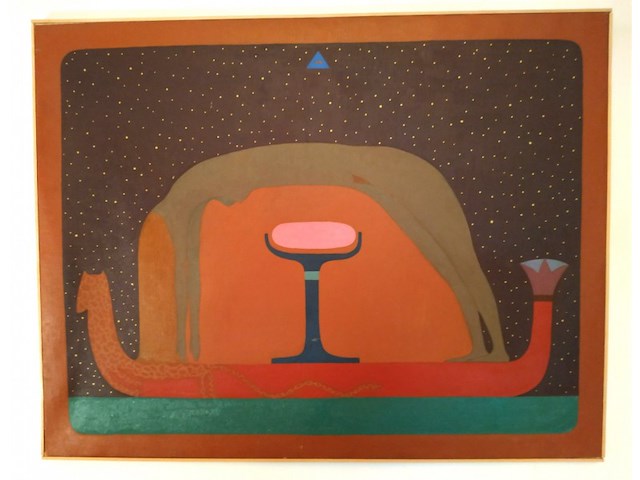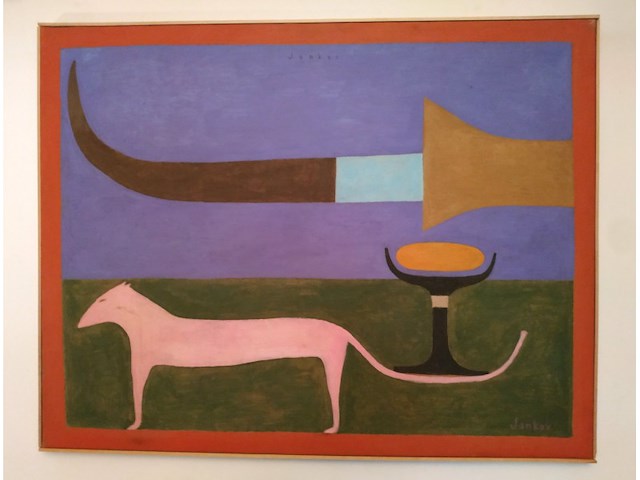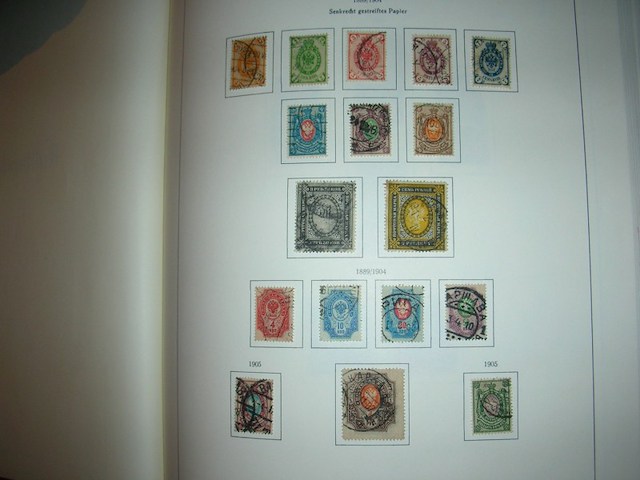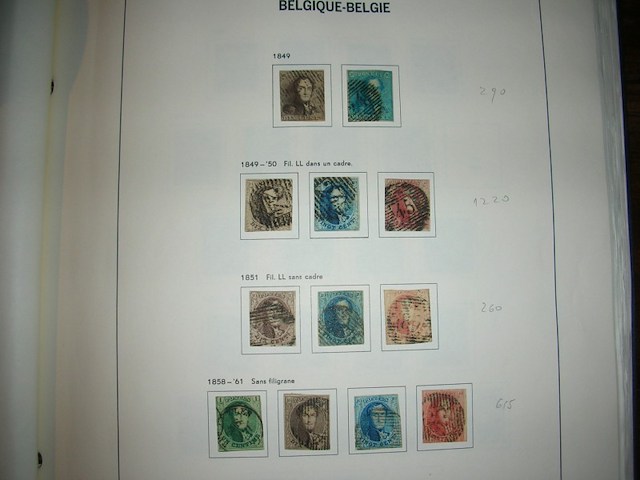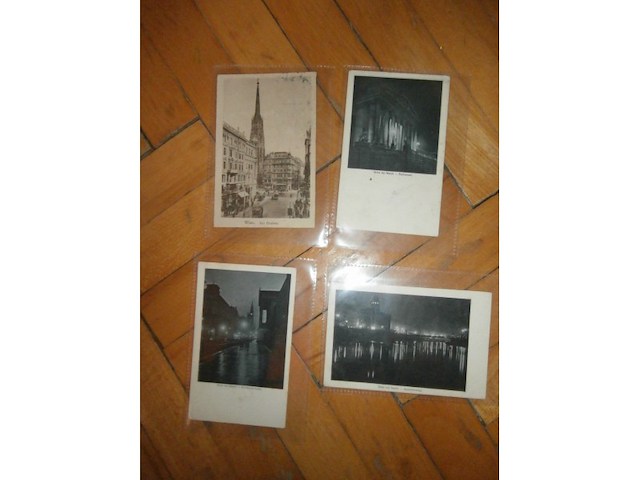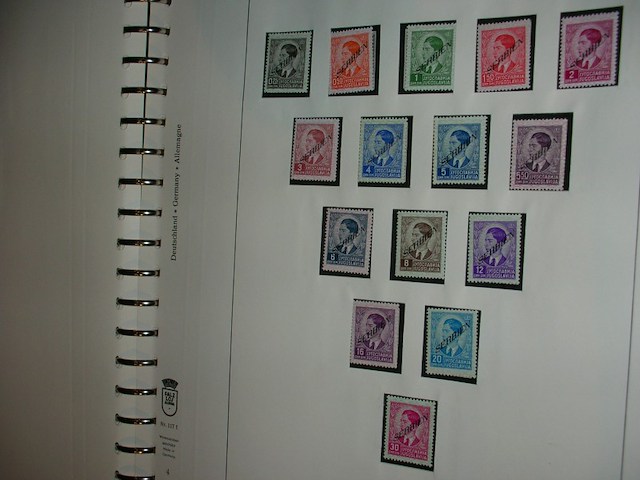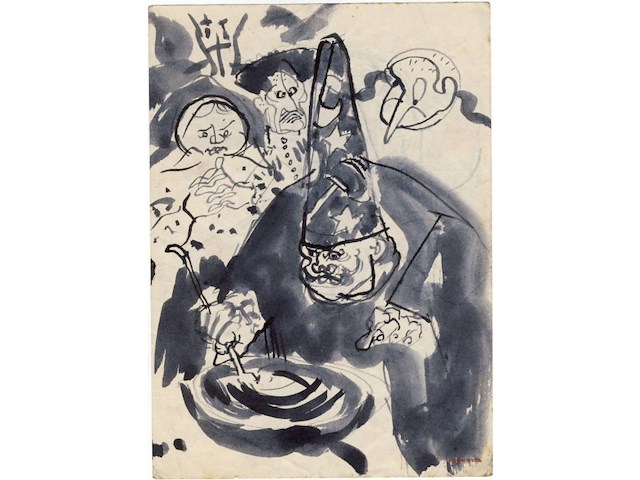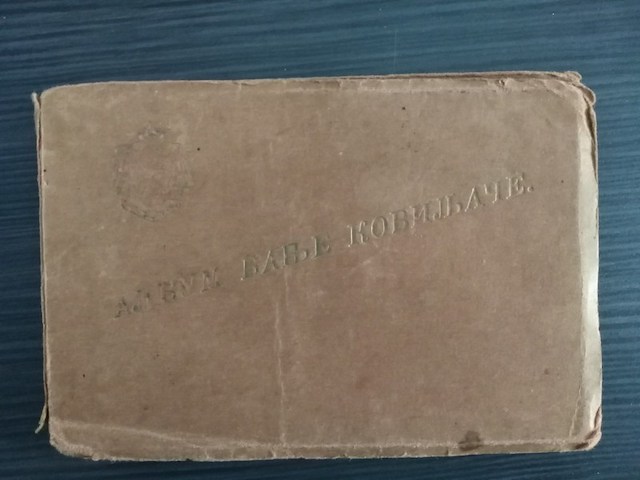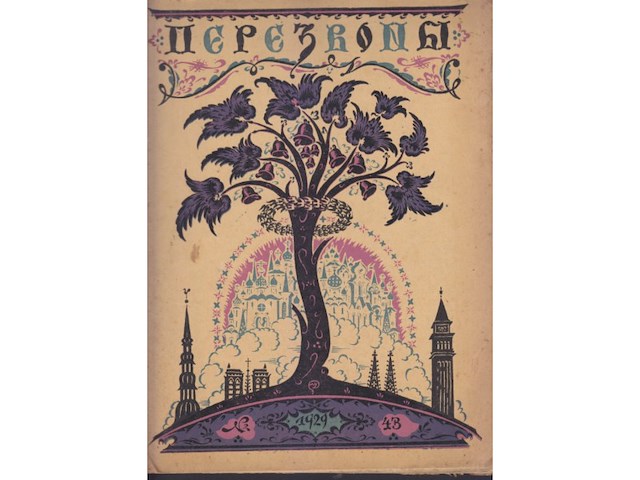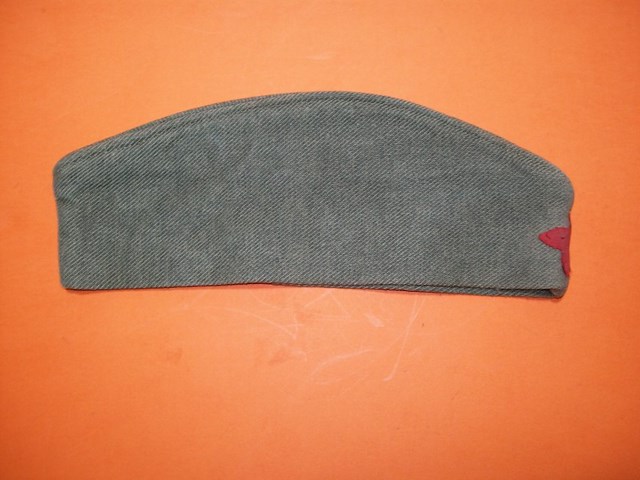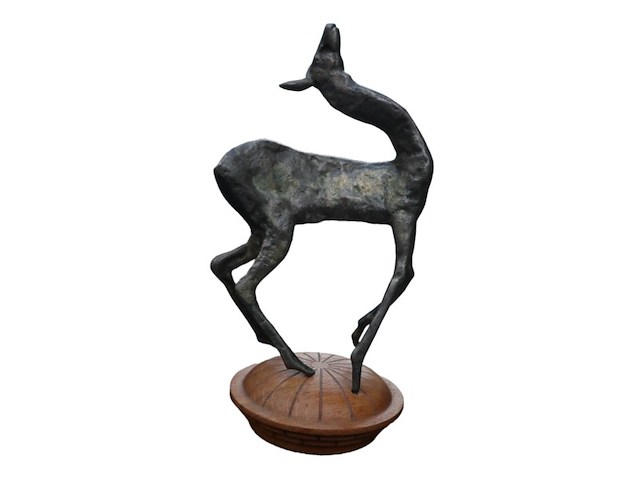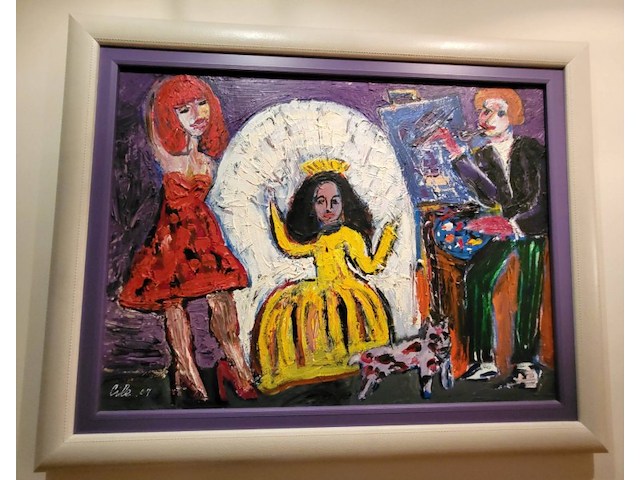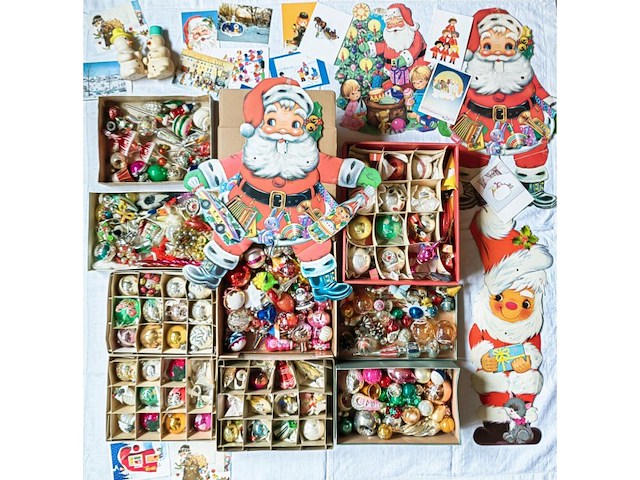Pratite promene cene putem maila
- Da bi dobijali obaveštenja o promeni cene potrebno je da kliknete Prati oglas dugme koje se nalazi na dnu svakog oglasa i unesete Vašu mail adresu.
126-150 od 1283 rezultata
Režim promene aktivan!
Upravo ste u režimu promene sačuvane pretrage za frazu .
Možete da promenite frazu ili filtere i sačuvate trenutno stanje
Aktivni filteri
Jugoslavija 1970 Umetnost PREDLOG SA UNETIM IZMENAMA Predlog maraka sa unetim izmenama, 6 pozicija sa odstampanom nominalnom vrednosti, ali prilikom kontrole od strane Andrije Milenkovica na svih 6 pozicija izvrsena je korekcija i olovkom obelezena nova pozicija nominalne vrednosti, koja se nalazi na kasnije prihvacenim i odstampanim markama. Marke su zalepljene na kartonskoj podlozi. Na trecoj slici koju sam postavi nalazi se serija maraka koja je pustena u promet, cisto da se vizuelno vidi razlika. Izuzetna retkost i prilika za ozbiljnog sakupljaca YU oblasti da unapredi svoju kolekciju. Za bilo koja dodatna pitanja stojim na raspolaganju. Placanje i isporuka iskljucivo LICNO u Beogradu. U slucaju da niste u mogucnosti licno da preuzmete, a zainteresovani ste, obratite mi se putem poruke pre same kupovine, radi detaljnijeg dogovora.
Zoran Petrović - Maja:IKONA SV. NIKOLA Enkaustika na drvenoj ploči. Dimenzije ikone sa ramom: 77 x 95 cm Dimenzije ikone bez rama: 65 x 83 cm Preuzimanje je moguće lično, u ateljeu autora, u Beogradu, ulica Vojvode Stepe. Slanje isključivo PostExpress-om, uz prethodnu uplatu. Ikona je rađena tehnikom enkaustike, starom slikarskom tenikom koja se upotrebljavala još u starom Egiptu, Grčkoj i Rimu, i čija originalna receptura ni do danas nije otkrivena u svim detaljima. Kombinuju se boje na uljanoj podlozi i boje na vodenoj bazi koje se mešaju sa rastopljenim čistim pčelinjim voskom. Nanosi se u slojevima, čime se postiže efekat vremenske patine, pri čemu svaki prethodni sloj mora biti u potpunosti osušen, tako da je rad dugotrajan, zahtevan i spor. Autoru je za izradu ove ikone bilo potrebno skoro godinu dana. Tehnika je danas u upotrebi kod samo nekoliko modernih slikara, i to u modifikovanom obliku. Kod nas je poznaju i ponekad koriste samo neki restauratori, od kojih je i autor učio ovu tehniku. Rezultat je specifičan i neponovljiv spoj: lik svetitelja, izuzetno poštovan i slavljen u srpskom narodu, prikazan retkom tehnikom koja dočarava protekle vekove, i umetnička interpretacija duhovne i verske snage ličnosti, što čini čine delo unikatnim. Ram je ručni rad iz 30-tih godina prošlog veka, u kojem je prvobitna bila uramljena slika Kralja Aleksandra. Ikonu je moguće kupiti i bez rama, i u tom slučaju cena je za 26.800 dinara manja. ZORAN PETROVIĆ-MAJA, akademski slikar, rođen u Beogradu, 1956. godine, gde i sada živi i radi. Posle studija boravio je u Nemačkoj, u Frankfurtu, gde se prikljucuje umetničkoj, multimedijalnoj grupi T.M. (Transcendental Meditation), i radi na performansima, videu i stripu. 1990. godine vratio se u Beograd, gde je osnovao likovnu grupu “Crtaj kao što pišeš”, sledeći osnovnu ideju Vukove jezičke reforme, pretočenu u likovni jezik. Bavi se i likovnim unapređenjem ćiriličnog slova i pisma, kao i originalnošću ličnog rukopisa, pisanog i likovnog, ukazujući da je svaki čovek originalan i samo jedan takav. Iste godine u saradnji sa Nedom Arnerić, njenom galerijom “Atrijum” i najpoznatijom beogradskom “Galerijom Kulturnog centra” u Knez Mihajlovoj ulici, pokrece akciju „Šansa za neafirmisane“, koja je trajala do 2006. godine i afirmisala oko 30-ak najtalentovanijih mladih umetnika. Pored upornog rada na podršci mladim umetnicima, Zoran Petrović posvetio se i humanitarnom radu: 1993. godine prikupio je znatan broj slika, kao donacije najpoznatijih srpskih slikara, i organizovao aukciju u Atini. Prikupljen novac utrošen je na lečenje srpskih ranjenika u Grčkoj. Dobitnik je više nagrada i priznanja. Radovi Zorana Petrovića-Maje nalaze se u brojnim privatnim i javnim kolekcijama širom Srbije. Slikar pažljivo vodi evidenciju o sudbini svojih slika, i za sada poseduje podatke o oko dvadeset kolekcionara kod kojih se njegove slike nalaze, od kojih četvoro poseduje i više od deset slika. Trenutno, preko dvadeset radova izloženo je u prestižnoj londonskoj galeriji `Londonart`. (86/38-KP/1)
-
Kolekcionarstvo i umetnost chevron_right Kolekcionarstvo
Stara grafika, naslov JUGEND. Ime autora Matias Walter? (nisam sigurna u prezime, jevrejski je umetnik). U porodici je odavno, baka je dobila od umetnika pred 2. svetski rat. Dimenzije sa originalnim drvenim ramom 19x25. Preko grafike je staklo. Ram je zagreban na samom donjem levom uglu. Poleđina ima tragove protoka vremena i stajanja. Pogledajte slike.
Velika slika naive iz 1978. godine, ulje na staklu jedne od začetnica hlebinske škole. Slike ove autorKe u ovakvoj dimenziji prodaju se po nekoliko hiljada evra. Rođena je 1935. godine u Hlebinama, spada u red cenjenijih autora naive u hrvatskoj- Slika je dimenzija 50*70 cm, preteska je i lomljiva jer je rađeno na staklu, tako da je moguce samo LIČNO preuzimanje. hlebine , hlebljanska , naiva , ulje na staklu
Autor nepoznat. sugerisano je Berber ali se to ne moze proveriti. odsjaj - refleksija na crnoj povrsini, folklornim motivima kao i na hodzinom licu u gornjoj desnoj cetvrtini slike (samo u tom delu) posledica je fotografisanja na dnevnom svetlu, inace taj deo rada isto izgleda kao mat crno obojena povrsina na gornjoj levoj strani slike odnosno gornjoj levoj cetvrtini slike, sam vrh - dekorativan rad. ulje na platnu, 72 x 72,5 cm plus dimenzije rama bez vidljivog potpisa i zapisa Hodza, dervis, muftija, Islam, Muslimani, Kuran, Quran, Qur`an, Koran, religija, motivi iz Bosne i Hercegovine, Bosna i Hercegovina, BIH
Radi poredjenja dat je snimak akvarela jedne Natalije Cvetkovic da se stekne uvid u slikarski nivo obrazovanja i dara Emila Krenajza. Emil KRENAJZ ( HRENEIS ) Beograd - termoelekrana Snaga i svetlost, o. 1933 akvarel, 19 x 28 cm signirano dole levo „Могао сам да зауставим Лењина!” ДНЕВНИК Суб, 10/23/2010 - 20:40 Да ли би европска и светска историја попримила другачији ток да је пред крај 1917. године аустријски генералштабни пуковник Емил Кренајз, потоњи сремскокарловачки грађанин, знао да се у блиндираном вагону из Швајцарске, преко Беча за Русију, превози главом и брадом друг Владимир Иљич Лењин? – Хатте ицх ја ес нур гењусст, хатте виелеицхт дас сцхицксал Еуропас ганз андере зукунфт ерлебт! (Да сам само тада ово знао, можда би будућност Европе сасвим другачију судбину доживела!) – записао је и дебелом линијом подвукао пуковник Емил Кренајз у свом дневнику, који је педантно и брижљиво водио. Биће да је овај човек врхунског образовања и широких интересовања често размишљао о томе, јер као да никад није прежалио то што су га „околности” омеле да спречи одлазак Лењиновог воза у Русију. Наиме, као начелник Општег одељења за транспорт при Главном генералштабу у Бечу, Емил Кренајз је добио новембра 1917. године запечаћени коверат као изузетно поверљив документ у ком је стајало да „блиндирани вагон композиције из Швајцарске, одређеног датума и часа, има проследити неотворен преко аустријске територије, од улазне до излазне границе”. Након два дана стигла је препорука с врха да одмах испуни оно што му је наређено, и то под претњом санкција „које ће утолико бити ригорозније пошто је он високи официр”. На крају је дошло до потпуног преокрета ситуације и Кренајз је елегантно склоњен на неколико дана са свог места. Преко веза у обавештајним круговима убрзо је пуковник Кренајз сазнао да је у блиндираном вагону, због чијег су га проласка послали на службени пут, био главом и брадицом – друг Лењин. – Очигледно – записао је касније Емил – наредбодавац је био добро упознат са садржајем блиндираног вагона и имао је посебне разлоге да то остане у највећој тајности. Тек, ретки су Карловчани који знају да је овај негдањи аустријски официр и потоњи директор Дунавског паробродског друштва, а заправо сликар, виноградар и винар, живео у њиховој вароши, а још мање је оних који су о њему нешто више чули. Пре 12 година у Карловачком музеју приређена је изложба његових радова сакупљених из установа и приватних колекција, али се чини да то ипак није било довољно да се сагледа сва питорескност његове личности. Највећи корак у намери да не ишчезне сећање на њега начинила је написавши књигу “Одолели забораву” Мирјана Кончар - Ђурђевић, у чијој је породици у Карловцима пуковник боравио до смрти. Емил Кренајз је родом из Петроварадина, односно Мајура. Рођен је 1872. у скромној породици немачког занатлије. Завршио је Карловачку гимназију с одличним успехом и наставио школовање на Војној академији Аустроугарске монархије. Од малена је био заинтересован за свет око себе, а све што би му се током школовања у Карловцима и у Аустрији догађало, бележио је оловком и бојама на папирићима. Од сликарског прибора и платна није се одвајао до последњих тренутака у животу. Оставио је иза себе много недовршених слика, за које је пред смрт рекао да ће се „ваљда једном наћи неко ’мазало’ које ће их довршити”. Пејзаже је радио акверелом, мртве природе уљем, портрете оловком или пастелом. Није желео да излаже то што је радио из чистог задовољства, тако да је једина његова изложба заправо та, приређена у Карловачком музеју 1998. године. По завршетку војне Академије и као добар познавалац речних путева добио је место у у Одсеку речне флоте при Главном генералштабу у Бечу, где је живео. Први светски рат проводи у Бечу обављајући поменуте дужности начелника Општег одељења за транспорт при Главном генералштабу. Списи кажу да је помогао многим ратним заробљеницима, међу којима је било и доста Срба. Крајем рата одликован је за изузетну хуманост показану током рата високим признањем, оредном витеза Малтешког реда, на предлог Међународног Црвеног крста. Након рата почео је да ради у Београду у представништву Дунавског паробродског друштва, а живео је мало у престоници, а мало више у Сремским Карловцима: код рођака у породици Кончар - Ђурђевић, код Јелисавете и Које. Кућа у којој је живео у Карловцима, у Улици митрополита Стратимировића, данас припада породици Шовљански. Убрзо је отишао и у пензију, посветивши се лову, риболову, виноградарству и наравно, сликању. Револтиран политиком Аустрије која се приближавала Хитлеровој нацистичкој идеологији, одрекао се пензије. То је образложио тиме да од „нове власти у Аустрији, која је фашистичког опредељења, не жели да прима више ни један пфенинг”. Приликом пописа у Карловцима 1941. године изјаснио се као Југословен, а када су му рекли да то више не постоји, одговорио је да је онда – “нико”. Касније су му понудили да постане члан Културбунда, одбио је и казао да се сматра Југословеном. Након провере, поново су га позвали, на шта је он одговорио је:„Ја, додуше, јесам Емил Кренајз, али Југословен”, после чега су га оставили на миру. Током рата у кући у Карловцима са њим су биле Јелисавета и две старице. Јелисаветина деца и муж живели су у Беогаду. Вероватно је та чињеница, а потом и развој догађаја након рата, навео Карловчане на сумњу у природу Емиловог и Јелисаветиног односа. Њу, иначе, памте као жену изузетне лепоте и елеганције, а када говоре о њој и “онклу”, како су Емила сви звали, чине то са посебним призвуком у гласу. Педесетих година Емил Кренајз је добио од Секретаријата за народну одбрану СФРЈ решење о додели пуковничке пензије. Умро је 1954. године и сахрањен на православном делу гробља на Магарчевом брегу, у породичној гробници Кончар -Ђурђевић и породице Милошевић. Нема дилеме, уз оне које је јако волео. - Зорица Милосављевић
Slika naive iz 1978. godine, ulje na staklu jedne od začetnica hlebinske škole. Slike ove autorKe u ovakvoj dimenziji prodaju se po nekoliko hiljada evra. Rođena je 1935. godine u Hlebinama, spada u red cenjenijih autora naive u hrvatskoj- Slika je dimenzija 30*40 cm, slika je lomljiva jer je rađeno na staklu, tako da je moguce samo LIČNO preuzimanje. hlebine , hlebljanska , naiva , ulje na staklu
Dragana Đurić-Kovačević Asterion, 1984, ulje na dasci, 35,3x33,8 cm, U pitanju je potraga za drugim znanjima. Veliki srpski naučnik, teoretičar matematike Milutin Milanković, vodeći autoritet za probleme osunčanosti Zemlje i povest ledenih doba, zapisao je: „U nama živi celokupna istorija života na Zemlji.” U autopoetičkom tekstu „Epifanija”, pisanom 1988. za časopis Delo posvećen drogama i stvaralaštvu, Hiršl je obelodanio svoju spoznaju i mentalni životopis kraljevskog uživaoca.3 Za njega, čuvara hipersenzibiliteta u sebi i drugima, nije nebitno da mu je majka bila pijanista i dekan Muzičke akademije u Beogradu. On je slikar i blok flautista, na likovnom planu tvorac neke vrste muzičkih slika i sinestezija. Misli se na njegovu prilagođenost na velike količine različitih psihostimulansa u dugom vremenskom periodu, kao i na obdarenost da stečena iskustva pretoči u slikarstvo i živu mudrost. „Usput sam gledao kako mnogi nestaju, sagorevajući brzo, u brišućem letu, kao zvezde padalice, odnoseći sebe i svoj talenat”, piše slikar i monah psihodelika o sudbini četrdesetak svojih prijatelja u Zagrebu i Beogradu koji više nisu živi. Slično je i sa mnogima u svetu. Samo su on i njegov saborac iz rane mladosti, Dragana Đurić-Kovačević, ezoterijska slikarka, naš najbolji poznavalac tarota, autor špila i knjiga, u svojoj generaciji uspeli da životno i estetski neozleđeni koriste psihotropne supstance.
Ulje na platnu, 77x103cm,bez rama, sa potpisom akademskog slikara Lukijana Bibića. Poznati slikar bio je i istoričar umetnosti, ikonopisac i monah (1895. - 1962.). Školovan u Beogradu, Minhenu, Beču, Pragu i Parizu. Delo nastalo početkom XX veka. Kolekcionarski primerak. Slika ima malo oštećenje nastalo od gelera za vreme bombardovanja Beograda 1941.g. Posedujem atest Nikole Kusovca.
-
Kolekcionarstvo i umetnost chevron_right Kolekcionarstvo
Postanske marke-kolekcija, retka prilika! Zbirka sadrzi 4 albuma sa markama, filatelistickim blokovima i tabacicima od Rusije 1889.-te godine pa do kraja SSSR-a. Za sva pitanja stojim na raspolaganju.
-
Kolekcionarstvo i umetnost chevron_right Kolekcionarstvo
Filatelistička kolekcija Francuske u albumu... Za sva pitanja stojim na raspolaganju.
-
Kolekcionarstvo i umetnost chevron_right Kolekcionarstvo
Poštanske marke Belgije u lux albumu, većinom žigosane, na falcu. Pozicije MiNr 708-2250 + period od 1849.-te do 1945.-te godine. Zbirka sadrži marke,blokove i tabačiće. Za sve što vas interesuje stojim na raspolaganju.
-
Kolekcionarstvo i umetnost chevron_right Kolekcionarstvo
232 različite i iz različitih perioda razglednice mesta u Austriji. Pojedinačne pogledati pod : Razglednica Austrija ... Ima i nekorišćenih, ali i onih koje su putovale
Poštanske marke Kraljevine Jugoslavije pod nemačkom okupacijom u drugom svetskom ratu i Nedićeve Srbije. Kolekcija vrhunskog kvaliteta u Lindner albumu sa zaštitnim folijama-ulošcima. Sve marke, tabačići i blokovi su MNH. Stojim na raspolaganju za dodatna pitanja.
Zna se da su u radu Bogoljuba Jovanovića najvredniji Madjioničari i Poslovice. Dalje nema. A o tome koliko je da se ne lažemo za eks-YU likovnu scenu u tom periodu Bogoljub Jovanović najznačajniji autor trebalo bi bez preterivanja pitati Vaska Popu, Stojana Ćelica, Miodraga Protića, Miodraga Dadu Djurića pa i sve Medijalce a i mnoge druge kojima je Bogoljub ukazao na pravi put kojim je trebalo da se ide. Bogoljub Jovanović (Beograd, 1924) Mađioničar, oko 1952 tuš i lavirung, 18,7 x 13,6 cm Reprodukovan u monografiji Muzeja Zepter.
-
Kolekcionarstvo i umetnost chevron_right Kolekcionarstvo
KVALITET KAO NA SLICI nekompletan karnet od 8 razglednica iz kraljevine Srbije. Izdanje Raje Vicentijevica - cuvenog trgovca. Izuzetno retke razglednice - neke motive nikad nisam video osim u ovom karnetu. Korice u zlatotisku sa grbom kraljevine Srbije... MOZETE POGLEDATI MOJU PONUDU I NA http://www.limundo.com/Clan/ministar/SpisakAukcija http://www.kupindo.com/Clan/ministar/SpisakPredmeta
ovo je lot od 32 broja ruskog knjizevno - umetnickog casopisa PEREZVONI (zvona) tacnije 31 sveska - brojevi 7 i 8 su izasli kao dvobroj ruska emigracija u latviji - riga izdavac : salamander naslovna strana : ilustracija M. Dobuzhinsky format : 29,5 x 22,5 cm, tezina oko 4 kg stanje lose. nedostaju pojedine reprodukcije, fleke nepoznato mi je koliko je brojeva izaslo. ovde (od 1 do 43) nedostaju brojevi : 1,3,9,12,14,18,20,23,25,26,30 i 33. rusija, emigracija,periodika samo srbija ove casopise ne saljem u inostranstvo serbia only I do not send these magazines abroad ---------------------------------- Било је потребно да прође стотину година да бисмо почели да се занимамо за Русе који су после 1918. дошли у наш град. Њихов утицај на развој друштва, науке, образовања и културе био је велики и зато је важно да сада, када је јавност заинтересована за ову тему, сазнамо праве чињенице о руској емиграцији у Србију. Велику победу у Првом светском рату Србија је несразмерно скупо платила јер се процењује да смо изгубили чак око 60 одсто мушке популације, између 1,1 и 1,3 милиона људи, односно трећину укупног становништва. Таква изнурена, рањена и сељачка Србија ушла је 1918. године неспремна у државну заједницу са Словенијом и Хрватском, које нису претрпеле ратна разарања и биле су привредно напредније. Сматра се да је око два милиона Руса напустило своју земљу после Октобарске револуције и пораза у грађанском рату. Око 40.000 дошло их је у Краљевину Срба, Хрвата и Словенаца, највише у Београд и друге веће српске градове. Краљ Александар је руске емигранте дочекао раширених руку због посебног односа са убијеним руским царем Николајем, који му је био кум. Уосталом, и краљ и принц Ђорђе били су руски кадети, а прича се да је Олга, једна од кћерки цара Николаја, била обећана југословенском монарху за супругу. Какав је однос руска царска породица имала према Александру Карађорђевићу говори и чињеница да је Марија Фјодоровна, мајка цара Николаја, завештала југословенском монарху икону Пресвете Богородице Филермоса, коју је насликао свети апостол Лука, шаку Светог Јована Крститеља и делић Часног крста. Те светиње предате су краљу Александру 1928. године после смрти руске царице у Копенхагену, а чуване су у посебној крипти на Белом двору. О структури руских емиграната сведоче подаци које је објавио Николај Степанов, дипломирани историчар Државног универзитета у Нижњем Новгороду. Он наводи да је само на једном од бродова који је упловио у Боку било 30 генерала, професора, доктора. Према Степанову, више од половине придошлих Руса били су војна лица и државни службеници, око 30 одсто радило је у привреди, а 14 одсто су били предавачи, доктори, писци, свештенство и уметници, уз пет одсто административног кадра. Према овим подацима, њих 13 одсто имало је високу стручну спрему, а само три одсто било је без икаквог образовања. Веома брзо је на чело универзитетских катедри у Краљевини дошло чак 28 руских професора. Руски професори чинили су четвртину наставног кадра Београдског универзитета, а на Пољопривредном и Медицинском факултету чак половину. Основали су интерну клинику Медицинског факултета. Својој новој домовини Руси су дали дванаест акадмика Српске академије наука, попут Георгија Острогорског, једног од највећих византолога двадесетог века. Руски уметници обновили су балет и оперу Београдског народног позоришта, а најзначајнији су балерина Нина Кирсанова и сценограф Владимир Ждерински. Прву глумачку школу отворио је редитељ Јуриј Ракитин. Утицаји Ђорђа Лобачева на развој српског стрипа, Константина Константиновича Егера на развој мачевања, или сликара Степана Фјодоровича Колесникова на наше сликарство, били су непроцењиви. У Београду је радило више од педесет руских архитеката, међу којима су најзначајнији Николај Краснов, Сергеј Смирнов, Василиј Баумгартен, Јуриј Коваљевски, Роман Верховски, Валериј Сташевски и Василиј Андросов. Они су пројектовали велики број јавних зграда које постоје и данас, попут зграда Главне поште, Владе Србије, Министарства иностраних послова, старог Генералштаба, Белог двора, Патријаршије, Руског дома, Цркве Александра Невског и Цркве Свете Тројице. У Београду су издавани и превођени модерни руски писци као што су Борис Пиљњак, Данил Хармс, Иљф и Петров, који су били забрањени у СССР-у. За претежно неписмену земљу, чија половина становништва није знала да чита и пише, то свакако није била мала ствар. Рецимо, у Србију је дошло између 1.200 И 1.500 инжењера, а имали смо их око 500. Први декан машинског факултета био је академик Владимир Фармаковски. Први шеф пилота домаће авио-компаније „Аеропут“, претече ЈАТ-а и „Ер Србије“, био је Владимир Стрижевски, а за ту компанију летели су многи руски пилоти попут Михаила Јарошенка, Виктора Никитина и Леонида Бајдака. Бајдак је заједно са Тадијом Зондермајером 1927. године летео од Париза преко Београда до Бомбаја. Лет је у том тренутку био најдужи на свету, а организован је да би се јавност заинтересовала за акције компаније како би била купљена четири путничка авиона. Зондермајер је 1926. године био учесник последњег двобоја револверима у Србији, а противник му је био тада млади писац Милош Црњански. Руси су издавали своје возачке дозволе јер их Србија до њиховог доласка није имала, основали су такси службу и водили су све такси станице у Београду. ---------------------------------------------- White Russian émigrés were Russians who emigrated from the territory of the former Russian Empire in the wake of the Russian Revolution (1917) and Russian Civil War (1917–1923), and who were in opposition to the revolutionary Bolshevik communist Russian political climate. Many white Russian émigrés participated in the White movement or supported it, although the term is often broadly applied to anyone who may have left the country due to the change in regimes. Some white Russian émigrés, like Mensheviks and Socialist-Revolutionaries, were opposed to the Bolsheviks but had not directly supported the White Russian movement; some were apolitical. The term is also applied to the descendants of those who left and who still retain a Russian Orthodox Christian identity while living abroad.[citation needed] The term `émigré` is most commonly used in France, the United States, and the United Kingdom. A term preferred by the émigrés themselves was first-wave émigré (Russian: эмигрант первой волны, emigrant pervoy volny), `Russian émigrés` (Russian: русская эмиграция, russkaya emigratsiya) or `Russian military émigrés` (Russian: русская военная эмиграция, russkaya voyennaya emigratsiya) if they participated in the White Russian movement. In the Soviet Union, white émigré (белоэмигрант, byeloemigrant) generally had negative connotations. Since the end of the 1980s, the term `first-wave émigré` has become more common in Russia. In East Asia, White Russian is the term most commonly used for white Russian émigrés, even though with some being of Ukrainian and other ethnicities they are not all culturally Russians. Most white émigrés left Russia from 1917 to 1920 (estimates vary between 900,000 and 2 million), although some managed to leave during the 1920s and 1930s or were expelled by the Soviet government (such as, for example, Pitirim Sorokin and Ivan Ilyin). They spanned all classes and included military soldiers and officers, Cossacks, intellectuals of various professions, dispossessed businessmen and landowners, as well as officials of the Russian Imperial government and of various anti-Bolshevik governments of the Russian Civil War period. They were not only ethnic Russians but belonged to other ethnic groups as well. Most émigrés initially fled from Southern Russia and Ukraine to Turkey and then moved to other Slavic countries in Europe (the Kingdom of Yugoslavia, Bulgaria, Czechoslovakia, and Poland). A large number also fled to Estonia, Latvia, Lithuania, Finland, Iran, Germany and France. Some émigrés also fled to Portugal, Spain, Romania, Belgium, Sweden, Switzerland, and Italy. Berlin and Paris developed thriving émigré communities. Many military and civil officers living, stationed, or fighting the Red Army across Siberia and the Russian Far East moved together with their families to Harbin (see Harbin Russians), to Shanghai (see Shanghai Russians) and to other cities of China, Central Asia, and Western China. After the withdrawal of US and Japanese troops from Siberia, some émigrés traveled to Japan. During and after World War II, many Russian émigrés moved to the United Kingdom, the United States, Canada, Peru, Brazil, Mexico, Argentina, Chile, Colombia, South Africa and Australia – where many of their communities still exist in the 21st century. Many, estimated as being between the hundred thousands and a million, also served Germany in the Wehrmacht or in the Waffen-SS, often as interpreters. White émigrés were, generally speaking, anti-communist and did not consider the Soviet Union and its legacy to be representative of Russia but rather of an occupying force. They consider the period of 1917 to 1991 to have been a period of anti-Christian occupation by the Soviet regime. They used the pre-revolutionary tricolor (white-blue-red) as their flag, for example, and some organizations used the ensign of the Imperial Russian Navy. A significant percentage of white émigrés may be described as monarchists, although many adopted a position of being `unpredetermined` (`nepredreshentsi`), believing that Russia`s political structure should be determined by popular plebiscite. Many white émigrés believed that their mission was to preserve the pre-revolutionary Russian culture and way of life while living abroad, in order to return this influence to Russian culture after the fall of the USSR. Many symbols of the White émigrés were reintroduced as symbols of the post-Soviet Russia, such as the Byzantine eagle and the Russian tricolor. A religious mission to the outside world was another concept promoted by people such as Bishop John of Shanghai and San Francisco (canonized as a saint of the Russian Orthodox Church Abroad) who said at the 1938 All-Diaspora Council: To the Russians abroad it has been granted to shine in the whole world with the light of Orthodoxy, so that other peoples, seeing their good deeds, might glorify our Father Who is in Heaven, and thus obtain salvation for themselves. Many white émigrés also believed it was their duty to remain active in combat against the Soviet Union, with the hopes of liberating Russia. This ideology was largely inspired by General Pyotr Wrangel, who said upon the White army`s defeat `The battle for Russia has not ceased, it has merely taken on new forms`. White army veteran Captain Vasili Orekhov, publisher of the `Sentry` journal, encapsulated this idea of responsibility with the following words: There will be an hour – believe it – there will be, when the liberated Russia will ask each of us: `What have you done to accelerate my rebirth.` Let us earn the right not to blush, but be proud of our existence abroad. As being temporarily deprived of our Motherland let us save in our ranks not only faith in her, but an unbending desire towards feats, sacrifice, and the establishment of a united friendly family of those who did not let down their hands in the fight for her liberation. The émigrés formed various organizations for the purpose of combatting the Soviet regime such as the Russian All-Military Union, the Brotherhood of Russian Truth, and the NTS. This made the white émigrés a target for infiltration by the Soviet secret police (e.g. operation TREST and the Inner Line). Tens of White army veterans (numbers vary from 72 to 180) served as volunteers supporting Francisco Franco during the Spanish Civil War. Some white émigrés, labeled `Soviet patriots,` adopted pro-Soviet sympathies. These people formed organizations such as the Mladorossi, the Evraziitsi, and the Smenovekhovtsi. After 1933, there were attempts to copy the NSDAP and cozy up to the German National Socialists, thus the short-lived parties such as the ROND (Russian Popular Liberation Movement) came into existence in Germany. One of the most notable forms of activities by Russian émigrés was building monuments to Russian war dead of World War I, which stood in marked contrast to the Soviet Union, which did not build any monuments to the 2 million Russians killed between 1914 and 1917, as the war had been condemned by Lenin as an `imperialist war`. Besides for the war dead, other monuments were put up. In Brussels, Seattle, and Harbin, monuments were built to honor the executed Emperor Nicholas II while a monument was put up in Shanghai to honor Alexander Pushkin, Russia`s national poet. In fact, a monument to Pushkin would have been built in Paris had not a dispute arisen with the Ministry of Fine Arts over its precise location. The popularity of monuments for the war dead reflected not only sadness over the war dead, but also a way to bring together the often badly divided émigré communities shattered across Europe, Asia and North America. Monuments for the war dead were often a way to symbolically recreate Russia abroad with example at the monument for those Russians killed while serving in the Russian Expeditionary Force (REF) in France at village of Mourmelon-le-Grand having a hermitage built near it together with transplanted fir trees and a Russian style farm to make it look like home. To built community consensus around the war memorials, the design of the memorials were deliberately kept simple with no sculpture which could be given a symbolic meaning, thereby ensuring that no particular interpretation of the war could be put forward other than grief over the war dead. The design of Orthodox churches at the war memorials was done in the style of medieval Orthodox churches in Novgorod and Pskov as this architectural style was seen as politically neutral and hence able to bring the communities together better. Both left-wing and right-wing émigré who otherwise passionately disagreed came together to honor the war dead of World War I, which was virtually the only occasions when overseas Russian communities could all come together, explaining why such memorial services were so important to the émigré communities. The neo-classical style which typically adorned war memorials in Imperial Russia was consciously avoided as building a war memorial in that style was viewed as expressing support for restoring the monarchy. The sense of loss was not only for those the war monuments honored, but due to the sense of loss caused by defeat with a columnist in an émigré newspaper in Paris writing about the dedication of a memorial to the REF in 1930: `We lost everything - family, economic situation, personal happiness, the homeland...Are our sufferings good to anyone? In truth-we have nothing, we have lost everything. Weep, weep`. Such monuments were also a way of commanding respect from the host communities with an émigré newspaper saying in 1930: `Peoples honor heroes. To the living: care, to the dead: memory. We in a foreign land do not have a tomb of an `unknown soldier`, but we do have thousands of suffering people. They are our honor and our justification (opravdanie) before the world. Their wounds and suffering are for Russia. They remain true to honor and obligation. That is our Russian passport`. This was especially the case in France, the home of the largest overseas Russian community, where services honoring the events of World War I were a major part of French life after 1918, and where by honoring the Russian war dead allowed the Russian émigrés in France to take part in the ceremonials, letting the émigrés feel like a part of the wider French community. In 1927, the Orthodox Metropolitan Evlogii when he spoke at the war monument in Valenciennes: `Blood spilled on the soil of beautiful and glorious France is the best atmosphere to unite France forever with a Russia national and worthy`. The fact that the crosses of the Russians buried in France were painted white-the color of the French war dead and allies-while the crosses of the German war dead were painted black was widely noticed within the Russian community in France as a sign that the French regarded them as allies. In Czechoslovakia and Yugoslavia, war memorials to the Russian war dead were presented in Pan-Slavic terms, as a symbol of how Russians had fought together with the Czechs and Serbs in the war. Serbian King Alexander of Yugoslavia was a Russophile who welcomed Russian émigrés to his kingdom, and after France, Yugoslavia had the largest Russian émigré community, leading to Yugoslavia to have almost as many war memorials to the Russian war dead as France. War memorials in Yugoslavia usually also honored both Serbian war dead and the members of the Czechoslovak Legions who died in the war, giving them a decidedly pan-Slavic feel. A planned Orthodox church to honor the Russian prisoners who died in an Austrian POW camp outside Osijek would have featured busts of the Emperor Nicholas II, King Peter I and King Alexander to emphasis how the Houses of Romanov and Karađorđević had been allied in the war, linking the Russian and Serbian experiences of the war. Between 1934 and 1936, an ossuary containing the bones of Russian soldiers killed all over the world was built in the Novo Groblje cemetery in Belgrade, which used to illustrate the theme of Serbian-Russian friendship, and which King Alexander contributed 5,000 dinars to meet the construction costs. When the memorial was opened in 1936, the Patriarch Varnava of the Serbian Orthodox Church declared in a speech opening it: `The Russians bore great sacrifices on our account wishing to defend Serbs at a time when powerful enemies attacked tiny Serbia from all sides. And the great Slavic soul of the Russians did not allow it to be looked upon with indifference that a fraternal Slavic people should perish`. Karel Kramář, a wealthy conservative Czechoslovak politician and a Russophile worked together with Russian émigrés to build an Orthodox church in Prague which Kramář called in his opening speech `a monument of Slavic connection` and to `remind Russians not only of their former sufferings but also about the recognition on the side of the Slavs`. A service at the Russian war memorial in Terezin in 1930 turned into `a Russian-Czech political demonstration in a manifestation of Slavic mutuality` with the theme that the Russians had died so that the Czechs might be free. Prague had a large community of Russian émigrés, and by constantly linking the Russian experience of World War I to the experiences of the Czechoslovak Legions was a way of asserting that the Russians had helped to make Czechoslovakia possible. In Germany, right-wing émigrés found much to their own frustration that right-wing German veterans shunned their offers to participate in Totensonntag (`Day of the Dead`) as German conservatives did not wish to honor the sacrifices of those who had fought against Germany, and it was left-wing German veterans, usually associated with Social Democratic Party, who welcomed having Russians participate in Totensonntag to illustrate the theme that all peoples in the nations involved in the First World war were victims.[18] In Germany, November 11 was not a holiday as no one wanted to honor the day that the Reich lost the war, and Totensonntag played the same role in Germany that November 11 played in the Allied nations, as the time to honor the war dead. The anti-war and internationalist message at the Totensonntag ceremonies organized by the SPD did not sit well with right-wing Russian émigrés found themselves rather out of place at these ceremonies. The city of Harbin in China was founded by the Russians in 1896, becoming known the `Moscow of the Orient` due to its Russian appearance, and after the Revolution its Russian population was further reinforced by émigrés, through the majority of the Russians living in Harbin were people who had come before World War I. About 127,000 people living in Harbin in 1920 came from Russia, making it one of the largest Russian-speaking cites in East Asia. Many of the Russians in Harbin were wealthy, and the city was a center of Russian culture as the Russian community in Harbin made it their mission to preserve the pre-war Russian culture in a city on the plains of Manchuria with for instance Harbin having two opera companies and numerous theaters performing the traditional classics of the Russian stage. The economic success of the Russians in Harbin often surprised foreign visitors who assumed that they should be poor, leading one visitor in 1923 to comment that Russian “ladies as well gowned as at the Paris races [who] strolled with men faultlessly garbed by European standards”, leading him to wonder how they achieved this `deceptive appearance`. The extent of Russian economic dominance of Harbin could be seen that “Moya-tvoya`, a pidgin language combining aspects of Russian and Mandarin Chinese which developed in the 19th century when Chinese went to work in Siberia was considered essential by the Chinese merchants of Harbin. White émigrés fought with the Soviet Red Army during the Soviet invasion of Xinjiang and the Xinjiang War of 1937. During World War II, many white émigrés took part in the Russian Liberation Movement. The main reason that pushed the Whites to support the German power with action was the concept of a `spring offensive`, an armed intervention against the USSR that must be exploited in order to continue the civil war. The latter was perceived by many Russian officers as an ongoing case that was never finished since the day of their exile.[26] During the war, the white émigrés came into contact with former Soviet citizens from German-occupied territories who used the German retreat as an opportunity to either flee from the Soviet Union, or were in Germany and Austria as POWs and forced labor, and preferred to stay in the West, often referred to as the second wave of émigrés (often also called DPs – displaced persons, see Displaced persons camp). This smaller second wave fairly quickly began to assimilate into the white émigré community. After the war, active anti-Soviet combat was almost exclusively continued by NTS: other organizations either dissolved, or began concentrating exclusively on self-preservation and/or educating the youth. Various youth organizations, such as the Scouts-in-Exile became functional in raising children with a background in pre-Soviet Russian culture and heritage. The white émigrés formed the Russian Orthodox Church Abroad in 1924. The church continues its existence to this day, acting as both the spiritual and cultural center of the Russian Orthodox community abroad. On 17 May 2007, the Act of Canonical Communion with the Moscow Patriarchate reestablished canonical ties between the Russian Orthodox Church Abroad and the Russian Church of the Moscow Patriarchate, after more than 80 years of separation. White émigrés, called `White Russians` in East Asia, flooded into China after World War I and into the early 1920s. Most of the Russians went to Manchuria (especially in Harbin, which at the time had the largest population of Russians of any city outside Russia) and treaty ports such as Shanghai, but a few ended up in Beijing. In 1924, the Chinese government recognized the government of the Soviet Union and the majority of White Russians in China who refused to become Soviet citizens were rendered stateless, thus subject to Chinese law unlike other Europeans, Americans, and Japanese living in China who enjoyed the principles of extraterritoriality. Nor were White Russians born in China eligible to be Chinese citizens. Although some of the White Russians arrived with their fortunes intact, most were penniless and due to ethnic prejudices and their inability to speak Chinese, were unable to find jobs. To support themselves and their families, some of the younger women became prostitutes or taxi dancers. They were popular with both foreign men, there being a shortage of foreign women, and Chinese men. A League of Nations survey in Shanghai in 1935 found that 22% of Russian women between 16 and 45 years of age were engaging in prostitution to some extent. The White Russian women mostly worked in the `Badlands` area adjoining the Beijing Legation Quarter on the east, centered on Chuanban Hutong (alley). The American explorer Roy Chapman Andrews said he frequented the `cafes of somewhat dubious reputation` with the explorer Sven Hedin and scientist Davidson Black to `have scrambled eggs and dance with the Russian girls.` Some did find professional work, teaching music or French. Other women took work as dressmakers, shop assistants and hairdressers. Many men became career soldiers of the Shanghai Russian Regiment, the only professional/standing unit within the Shanghai Volunteer Corps. By slow degrees, and despite the many difficulties, the community not only retained a good deal of cohesion but did begin to flourish, both economically and culturally. By the mid-1930s there were two Russian schools, as well as a variety of cultural and sporting clubs. There were Russian-language newspapers and a radio station. An important part was also played by the local Russian Orthodox Church under the guidance of St. John of Shanghai and San Francisco. Approximately 150,000 White Russians, including princes, princesses, generals and senior officers, fled to the Ottoman Empire in the wake of the Revolution. Istanbul, which had a population of around 900,000 at that time, opened its doors to approximately 150 thousand White Russians. The parties to the war migration in 1917 were neither Crimean Turks nor Caucasian Muslims. This time, those who took refuge in Istanbul were the `nobles` and soldiers of Tsarist Russia, who had fought the Ottomans for centuries. The immigration, which started with small groups at the end of 1917, grew with the loss of Crimea to the Bolsheviks in 1920. Tens of thousands of people who left their titles, money and palaces in Russia and came to Istanbul tried to hold on to life by dispersing all over the city. Some sold books, some handcrafted souvenirs and some flowers. The place, formerly known as Hristaki Passage, became known as Çiçek Pasajı after the Russian flower girls took up residence. Russian refugees. Those who arrived in 1919 were better off economically. The first arrivals found some jobs in the French and British representations, commissions, or alongside them in civil service, translator, or even military or security units in Istanbul.
-
Kolekcionarstvo i umetnost chevron_right Kolekcionarstvo
Partizanska titovka
Jovan Soldatović (1920 - 2006) dolazi kao Djordje Balašević vajarskog sveta i drugi kapetan panonske ladje ... u njegovom opusu kao najreprezentativniji komad po kom je najvise poznat izdvaja se upravo ova graciozna Košuta, oko 1970 - primerak koji dobijate je fotografisan i nalazi se na snimku koji ste upravo videli materijal : bronza visina sa drvenim postoljem oko 36,5 cm odlivena za života umetnika skulptora Jovana Soldatovića ... može se utvrditi po originalnom postolju na fotografijama koje smo napravili i postavili u prilogu vidi se nekoliko primeraka slične skulpture u direkciji modne kuće Mona što je dokaz da ovaj motiv spada u sam vrh jugoslovenske vajarske / kulturne scene ...
Milan Cile Marinkovic, U ateljeu, 2007- ulje na platnu. Slika ima uobicajen nacin obelezavanja sa zadnje strane ( ko ima njegove slike razume, za kupce svakako dostupno)- Ciletovnaziv slike ` PORODIČNI DOGAĐAJI U RAZNIM SCENAMA`. iz LINCUBO IV ciklusa, ja sam ga skratila u ` U ateljeu` posto u oglas ne moze da stane pun naziv. Signirana dole levo. Kupljena u Ciletovom ateljeu, kao i sve njegove slike iz moje kolekcije. Zainteresovani za ovog jedinstvenog autora na mom profilu će uskoro moci da pronađu jos ponesto iz njegovog stvaralackog opusa. Ram je Fabris, omogucava da slika dođe do izrazaja ( po meni se Cile najbolje tako rami kada su u pitanju ovakva dela) i 2 klasicna rama. Tehnika: Ulje na platnu Dimenzija bez rama:80x60 Dimenzija sa ramom:99x79 Godina nastanka: 2007. Milan Cile Marinković (Beograd, 25. januar 1947) je srpski slikar, sledbenik pop arta, novog ekspresionizma i transavangarde, član Udruženja likovnih umetnika Srbije. Rođen je 25. januara 1947. godine u Beogradu. Akademiju likovnih umetnosti u Beogradu je upisao 1966. godine na slikarskom odseku u klasi Mirjane Koke Mihać (1924-2006). Prvu samostalnu izložbu imao je još tokom studija u Galeriji Doma omladine 1970. godine. Naredne 1971. godine je kao najmlađi učesnik izlagao na XII Oktobarskom salonu. Diplomirao je 1972. godine u klasi profesorke Ljubice Cuce Sokić, redovnog člana Srpske akademije nauka i umetnosti, koja je podržavala njegovu autentičnost. Član je Udruženja likovnih umetnika Srbije od 1973. godine. Dobio je stipendiju 1977. godine za usavršavanja u Parizu. Sa suprugom Zoricom Bebom Krupež, po stuci diplomiranim ekonomistom, dobio je 1986. godine kćerku Danicu, a preselili su se u Pariz 1993. godine. Imao je preko 95 samostalnih izložbi, dok je uzeo učešća na više od 250 kolektivnih izložbi. Slikar je jedinstvenom slikarskog izraza!
-
Kolekcionarstvo i umetnost chevron_right Kolekcionarstvo
Jedinstveno i prelepo na jednom mestu,muzejski eksponati.Samo licno preuzimanje u Beogradu na mojoj adresi
